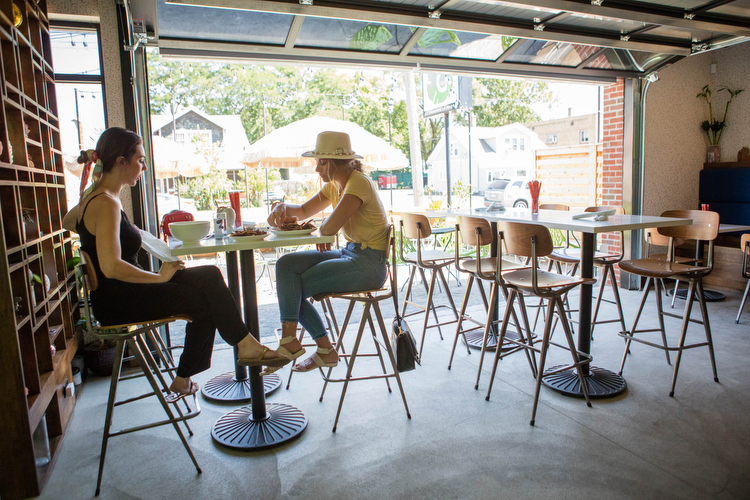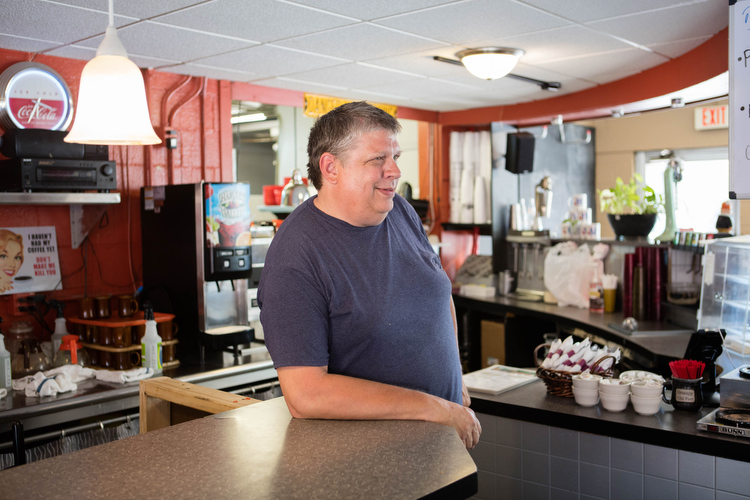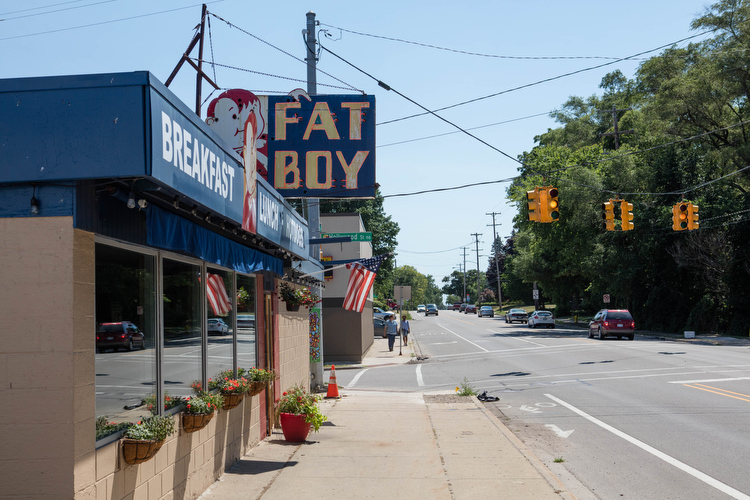Neighborhoods of GR: What the North Quarter CID’s plan means for Cheshire Village
Thanks to the North Quarter Corridor Improvement District (CID), residents along Plainfield on the North East side can expect new development in the area. Hoping for similar developments seen in Creston Business District, Cheshire Village may become GR's next destination neighborhood.

Thanks to the North Quarter Corridor Improvement District (CID), residents along Plainfield on the North East side can expect new development in the area. Approved in 2012, the North Quarter CID’s Development Plan seeks to foster a sense of place in this area using infrastructure and beautification projects meant to boost tax revenue and encourage investment from entrepreneurs.
The North Quarter corridor, which mostly runs along Plainfield north out of downtown and ending short of 3 Mile, is planned to become another destination neighborhood while retaining its unique character. Like other CIDs in Grand Rapids, the North Quarter designated a board to manage a tax and investment plan to encourage focused multi-use development. Already, residents of both the Creston and Cheshire business districts contained within are seeing the change. If all goes according to plan, the North Quarter as a whole is slated to become a greener community where residents and business are better able to welcome and accommodate walkers, bikers, and drivers alike.
Thanks to cooperation from the Creston Neighborhood Association, who oversees the two business districts, and a renewed confidence among entrepreneurs looking to invest in the area, the North Quarter CID’s plan has seen quick results.

Many of the development plan’s earliest design projects are already implemented in both neighborhoods. Bike lanes can be seen along most of Plainfield in this district. Protected bike paths and roundabouts have been installed along Monroe. Bike racks too have become more common outside of businesses. Outside the new City High School, running south all along the heart of the Creston business district, concrete medians with trees and greenery were added on Plainfield.
New retail and food service oriented businesses, like Creston Brewery, Citizen Tiki Bar and Restaurant, and Switchback Gear Exchange, have opened in the area, with some like Citizen choosing the more transparent storefronts encouraged in the plan. The improvements Grand Rapids has already seen in both the Creston and Cheshire business districts will help to lay the groundwork for long term design projects, some of which are larger infrastructure investments.
As the CID’s Development plan progresses past its five year goals into its longer term projects, residents can likely expect to see even more, larger investments in the district. Like the first phase, these midrange and long term design goals center around improving walkability and making transit more convenient for those outside the neighborhood.
The plan notably calls for both traffic calming measures and improvements to parking. We’ve already seen some of the smaller scale projects starting, but other plans include improvements to multi-use roadways, bus stops, park benches, crosswalks, wayfinding signage and added waste receptacles, greenery, dog clean-up stations, and permanent planters. Some of the more bigger, longer-term projects proposed include adding public exercise stations, a dog park, pocket-parks, public fountains, and even maybe one day an amphitheatre. Among perhaps the most ambitious project, scheduled to begin in 2020, is a plan to consider adding a bus rapid transit (BRT) or light rail light rail system to Plainfield.
While the viability and the funding of many of these ideas remains to be determined, residents can hope that they find room in the budget for the most practical of these projects. Which projects, when exactly, and what specific business districts they are built in still remains to be determined. This planned infrastructure has been attracting new investors, hoping to be a part of a walkable business corridor.

Rachel Lee, owner of Citizen Tiki Bar and Restaurant, is a relatively new investor in the North Quarter, but in the Cheshire Village business situated a bit north of the Creston business district. Citizen Tiki Bar was opened in December of 2017, when Lee noticed a demand for a full service restaurant and bar in this neighborhood. While Creston was seeing newer destinations like Creston Brewery and Lucy’s Cafe pop up, Cheshire Village had lagged behind. When she opened, Cheshire Village had restaurants, like Cheshire Kitchen, and places to grab a drink, like The Tap inside Northfield Lanes, but not somewhere for both. This wasn’t the only demand investors have noticed in this business district, either.
Right across the street from Citizen, two more restaurants are in the works for Cheshire Village, too. One is planned to have a patio with scheduled live music. The other is to be a cafe that’ll serve breakfast, lunch, and dinner. Investors like these and Lee seem to be growing confident that the large residential population, plans for further investment in the region, and recent investments in the Creston business district nearby will help push development in this area forward and help returns.
“When you look at urban business districts, it’s about the mix,” Lee says. She describes the Cheshire Village business district as lacking much retail aside from places like Switchback Gear Exchange, Mission India Super Thrift, and the Dollar General. She wants to see more investment and strong business to business relationships and her emphasis is on cooperation among business owners in the area. Together, she feels investors can turn the Cheshire Village business district into another distinct Grand Rapids destination, and the CID agrees.

Lee feels that the more business that comes to the Cheshire Village, the healthier the overall commercial ecosystem will be. Further helping business interests in this neighborhood is the North Quarter CID’s emphasis on multimodal development, which can increase foot traffic too. In this case, multimodal development might take the shape of adding housing to commercial properties. We see this consideration reflected in the fact that two of the area’s forthcoming restaurants are to have apartments above them. This type of development is important to generate what Lee describes as, “street presence.”
Diverse retail and service options for consumers is key to pulling in the type of foot traffic she and the North Quarter CID want. Increased foot traffic from this type of business investment helps to create incentives to implement the investments the CID has proposed like additional crosswalks. These investments and traffic calming measures then, in turn, can help further increase foot traffic again helping business. The overall goal being to build a more walkable community.

However, there are barriers to this goal. The heart of the neighborhood, Plainfield Avenue itself is an important motor route for the city, connecting highways and bisecting the city as it connects to Division. Matt Urbane, owner of Fat Boy Burgers at the northernmost edge of Cheshire Village, was quick to address this problem.
“Plainfield has been and always will be a thoroughfare from the south to the north,” he says. And indeed, if Cheshire Village hopes to pull people from downtown, or elsewhere in the city, consideration for transit must be made. For Fat Boy and other businesses in Cheshire Village, urban parking is a major issue. “People won’t stop where they can’t pull up in front,” he says. Legacy businesses like Fatboy want more foot traffic, but not at the cost of their current customers, many of whom drive. However, parking isn’t the only thing that’s helped Fat Boy stay in business that Cheshire Village needs to protect as it develops.
Fat Boy Burgers has been a staple of Cheshire Village for nearly 65 years now, and many neighborhood residents share fond memories of the establishment. Urbane says many of these people grow up and move out of the neighborhood but often return with their families, mostly by car. Urbane himself grew up in the neighborhood and had fond memories walking to eat at Fat Boy after school in the old Creston High, where City High is now.

When Urbane bought the restaurant in 2009, he was excited to continue the tradition, and keep something special about Cheshire Village alive. Urbane says he doesn’t see as many kids making the walk over after school anymore, in part because of new competition and in part because of the traffic. Memories like these, of a time when people could walk through their neighborhoods, moments that generate a sense of place, seem to be what inspired the CID’s development plan.
These moments, like the one Urbane described, are part of what makes the Cheshire Village home. It gives it the “sense of place” the CID is looking to cultivate, enrich, and preserve. While the idea of a “walkable community” might feel newfangled, it’s not an inaccurate way to describe how Cheshire Village once operated. Before cars became so important, residents of this neighborhood had everything they needed: a pharmacy, a bank, a restaurant, entertainment and even a candy shop, all within walking distance.
The CID’s plan, at least in Cheshire Village, seems to be to restore walkability, not enforce it where it was not, all while helping to increase revenue for the area. And while, more money is always an incentive, residents and business owners seem most excited to welcome people from all over Grand Rapids to their homey neighborhood: Cheshire Village.
Photos by Adam Bird of Bird + Bird Studio.









